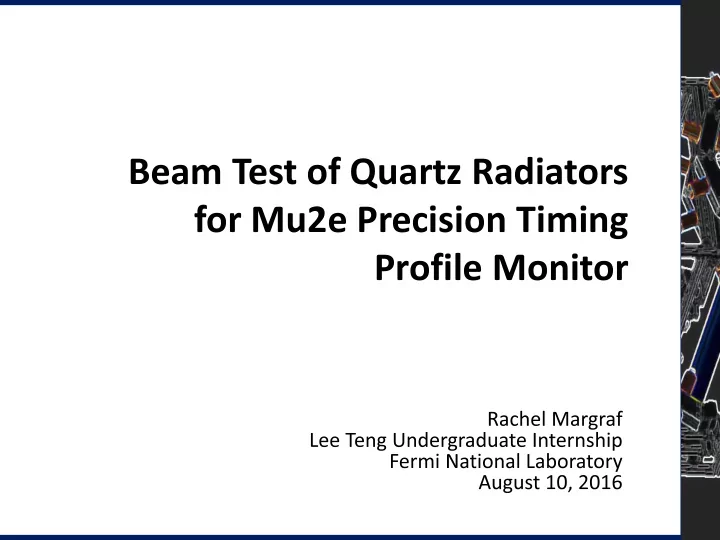

Beam Test of Quartz Radiators for Mu2e Precision Timing Profile Monitor
Mu2e Weak Force Decay (common) Direct Conversion (signal) • Search for Charged Lepton Flavor Violation (CLFV) in the form of neutrino-less muon to electron conversion (μ → e + γ). • Neutrinos mix, quarks interconvert, why not leptons?
- e π μ Production Target Stopping Target • Collide protons into production target, produce pions that decay into muons • Capture muons around aluminum nuclei • If a muon converts to an electron by exchanging a photon (or other particle) with the nucleus, the electron will be given off at 105MeV • Limit search to after background products have decayed • Out of time particles may still appear in this window -> Precision Timing required!
Precision Beam Timing Monitor • Ratio of out of time protons to in time protons (“extinction”) must be 10 -5 in the recycler and delivery ring, and 10 -10 at production target • Upstream monitor (left) • 4 arms with 4 Quartz Cherenkov Radiators each • Detect protons scattered off a thin foil in the beam • Build statistical profile of out of time protons
Quartz Cherenkov Radiators Quartz Cherenkov light produced when a charged particle travels faster than light can travel in a medium Advantages over Scintillators: Relativistic • Insensitive to low energy backgrounds Proton • Low afterglow after large signals Light “shockwave” Disadvantage: PMT • Smaller signal (Amplification) Signal Out
Beam Test Setup: 4 Quartz radiators 1”x1”x1” attached to photomultiplier tubes (PMTs) mounted to remotely controlled table 4 3 2 1 Beam 30 cm 2 Scintillator Triggers Removable Lead Brick
One Proton Event Signals • Interested in: • Amplitude of Signal • Arrival Time of Signal • Out of Time Signals
Amplitude of Signals (maximum in-time peak) -0.1075V -0.2825V -0.2325V -0.1225V
Resultant Efficiency 15000 events Quadruple Coinc. Triple Coinc. Efficiency (99.97 ± .02)% Quartz 1 14771 14775 (99.78 ± .02)% Quartz 2 14771 14804 (99.86 ± .02)% Quartz 3 14771 14792 (99.05 ± .02)% Quartz 4 14771 14912 (98.67 ± .05)% Four-Fold Efficiency Number of Quadruple Coincidences Efficiency Quartz # = Number of Triple Coincidences in other Three Channels FourFold Efficiency = Efficiency Q1 • Efficiency Q2 • Efficiency Q3 • Efficiency Q4
Signal Arrival Time – In Time Signals • 0ns is the trigger time • Defined “In Time Signals” as between -50ns to 0ns for Quartz 1-3, and -50ns to 10ns for Quartz 4 • Signals occur before 0ns because trigger signal passed through more electronics/wires on route to oscilloscope
Time Resolution δ 2(t 4 −t 1 ) = δ 2(t 4 ) + δ 2(t 1 ) If δ 2(t 4 ) ≈ δ 2(t 1 ) ≈ δ 2(𝑢) δ (t 4 −t 1 ) = 2 δ (t) ≤ 1.539ns Timing Resolution: δ t ≤ 1.09ns • By taking the difference between two channels, smaller time resolution • Difference between channels 1 and 4 had the largest RMS • Time resolution is 1.09ns or better
Multiple After Proton Event Pulsing • If caused by out of time protons, usually leave track in all four quartz • After pulsing occurs randomly, usually just in one channel • If there is time structure in after pulsing, however, higher possibility of false coincidence 26000 events Out of Time Signals Probability .00342 ± .00004 Quartz 1 89 .00238 ± .00004 Quartz 2 62 .00500 ± .00004 Quartz 3 130 .00115 ± .00004 Quartz 4 30 (4.7 ± .4)• 10 -11 Pred. 4-Coinc. 0 .00088 ± .00004 Obs. 4-Coinc. 23
• Random arrival times, esp. for quadruple coincidence Quadruple Coincidences • May be small amount of after pulsing around ~100ns for Quartz 1 & 3 • To calculate probability of this producing false quadruple coincidence, tested how often a record with an out of time signal had an out of time signal in previous record of same channel: 26000 events Events Probability <2 •10 -18 (for 4 channels) Obs. Self-Coinc. 0
• Signal generated by Quartz Radiators is sufficient to detect protons with high efficiency (98.7%) • Signal time resolution is 1.09ns or better • After pulsing will at worst produce quadruple coincidences at a rate of 2•10 -18
[1] C . B. Mott, “Research and Development for the Mu2e Extinction Monitor,” M.S. Thesis, Physics Dept., Northern Illinois Univ., De Kalb, IL, 2016. [2] E. Prebys, M. Jamison- Koenig, L. Rudd, “Tests of Quartz Radiators for Beam Precision Timing Monitor.” Beams -doc #5018-v3, 2015. [3] L . Rudd, “Characterization of Quartz Radiators for Mu2e Upstream Extinction Monitor,” Beams -doc #5016-v1, 2015. [4] S. Werkema , “The Fermilab Muon Campus – The Experiments, Projects, and Status,” Beams -doc #4716-v1. [5] H. Alaeian , “An Introduction to Cherenkov Radiation,” (15 March 2014), [Online], Available: http://large.stanford.edu/courses/2014/ph241/alaeian2/. [6] D. Hedin, E. Prebys , “Technical Scope of Work for the 2016 Fermilab Test Beam Facility Program,” Beams -doc #5203-v1.
e - Muon to Electron γ or ? - - Conversion (Signal) e - Radiative Pion π - Capture γ π - (Background) e + • Pions can also be captured by Al nuclei and produce e - around the signal energy • Limit search window to after pions have decayed • Cannot exclude out of time pions -> precision timing of beam required!
Recommend
More recommend